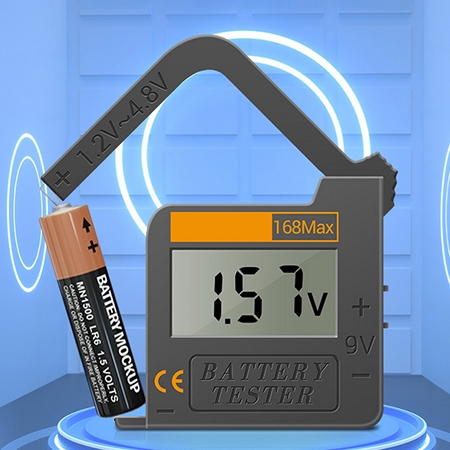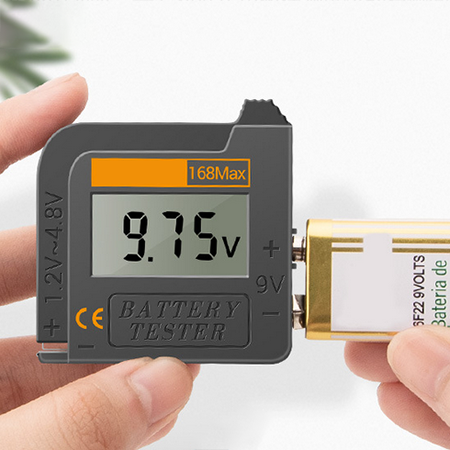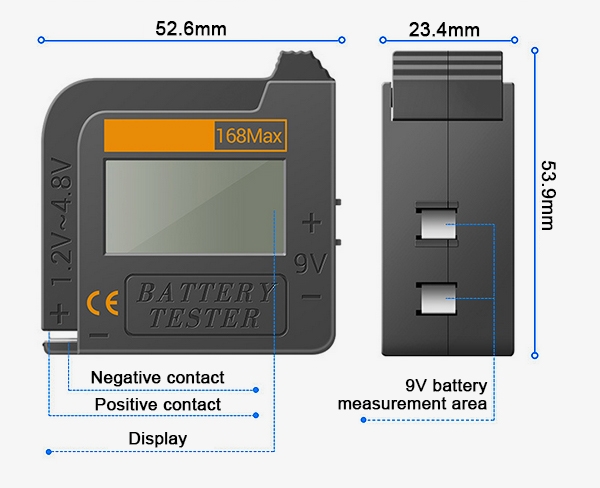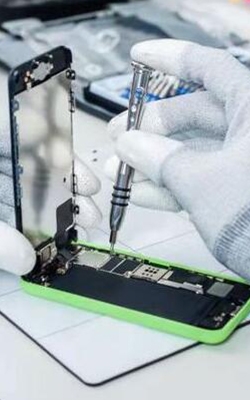The battery tester for AA batteries is made of ABS insulating material and features upper and lower sliding handles that can be extended up to 90mm, making it convenient for measuring the energy of batteries ranging from 1.2V to 4.8V. The LCD display is clearly visible, and the battery charger tester is compact, lightweight, comfortable to use, and has a sleek design.

Clear LCD Display, Up-and-down sliding handles
- The LCD screen of the household battery tester displays the battery voltage, ensuring clear visibility from all angles.
- The up-down sliding handle of the battery cell tester facilitates measurement of 1.2V to 4.8V batteries, with a maximum extension of 90mm.
- The battery capacity tester can measure various battery types, including 1.5V AA/AAA batteries, 3V button batteries, 9V 6F22 batteries, and 3.7V lithium batteries, without having to use the battery itself.

Sturdy ABS Insulation, 9V battery testing area
- The ABS insulation housing ensures the lithium battery tester's durability and safety.
- The right side of the battery checker tester is the 9V battery test zone, requiring testing of the positive and negative terminals of the corresponding battery.
Battery Tester For Household Size

Application
A small battery tester can be used to measure the remaining battery power in daily life, detect whether the battery has power to quickly determine whether the battery can still be used. In school science teaching activities, they are used to demonstrate knowledge related to battery voltage and current. Battery energy can be tested at any time during business trips and travel.

Science Activity

Travel

Battery Recycling

Energy Testing
| Model | SISCO-BT-168MAX |
| Measurement Range | 1.2V~4.8V/9V battery |
| 1.5V Battery No. 1 | √ |
| 1.5V Battery No. 2 | √ |
| 1.5V Battery No. 5 (AA) | √ |
| 1.5V Battery No. 7 (AAA) | √ |
| LR44/ 1.5V Button Cell Battery | √ |
| CR2032 3V Button Cell Battery | √ |
| 6F22 9V Battery | √ |
| 16340 3.7V Lithium Battery | √ |
| 10440 3.7V Lithium Battery | √ |
| 18650 3.7V Lithium Battery | √ |
| 14500 3.7V Lithium Battery | √ |
| 21700 3.7V Lithium Battery | √ |
| Materials | ABS insulated plastic casing |
| Battery | No battery required |
| Dimensions | 52.6 mm/23.4 mm/53.9 mm |
| Display | Digital display screen |
| Weight | 29.2 g |
Q1: What is a home battery tester?
A1: A home battery tester is a portable electronic testing device primarily used in the home to quickly measure and evaluate the performance parameters of various batteries, helping users determine the battery's health, remaining charge, and whether it needs replacement.
Q2: How does a home battery tester work?
A2: A battery tester measures the terminal voltage of a battery by contacting its positive and negative terminals. This tester doesn't require battery power itself; instead, it uses a weak current supplied by the battery under test to drive a voltage display circuit (usually an LCD screen), providing instant readings.
Q3: What can a home battery tester be used for?
A3: It can quickly determine whether a battery is still usable, saving time and money on replacing batteries. It can also be used to demonstrate battery voltage and current in schools or at science events.
Tips: How to maintain a household battery tester?
Use a damp cloth and detergent to wipe surfaces, avoiding corrosive solvents such as alcohol. When cleaning voltage test clips and current probes, gently wipe the metal contacts with a damp cloth to prevent oxidation that affects conductivity. Dry thoroughly after cleaning. Regularly clean device plugs, sockets, and filters to prevent dust from clogging air paths and causing poor connections.
Thank you for buying industrial test and measurement equipment on SISCO.com, all products sold by SISCO and the partner cover a 12 months warranty, effective from the date of receiving the products.
What is covered?
SISCO is responsible for providing free spare parts, and free technical support to assist the customer to repair the defective products until the problem is solved.
What is not covered?
- Product purchased from anyone other than a SISCO store or a SISCO authorized reseller.
- Expendable parts.
- Routine cleaning or normal cosmetic and mechanical wear.
- Damage from misuse, abuse or neglect.
- Damage from use of parts other than SISCO approved.
- Damage from use outside the product’s usage or storage parameters.
- Damage from use of parts not sold by SISCO.
- Damage from modification or incorporation into other products.
- Damage from repair or replacement of warranted parts by a service provider other than a SISCO authorized service provider.
- Damage caused by the application environment not meeting the product usage requirements and the failure to perform preventive maintenance.

